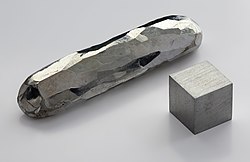Cadmium
Cadmium occurs as a minor component in most zinc ores and therefore is a byproduct of zinc production. It was used for a long time as a pigment and for corrosion resistant plating on steel while cadmium compounds were used to stabilize plastic. With the exception of its use in nickel–cadmium batteries and cadmium telluride solar panels, the use of cadmium is generally decreasing. These declines have been due to competing technologies, cadmium’s toxicity in certain forms and concentration and resulting regulations. Although cadmium has no known biological function in higher organisms, a cadmium-dependent carbonic anhydrase has been found in marine diatoms.
Occurrence
Cadmium makes up about 0.1 ppm of the Earth's crust. Compared with the more abundant 65 ppm zinc, cadmium is rare. No significant deposits of cadmium-containing ores are known. Greenockite (CdS), the only cadmium mineral of importance, is nearly always associated with sphalerite (ZnS). This association is caused by the geochemical similarity between zinc and cadmium which makes geological separation unlikely. As a consequence, cadmium is produced mainly as a byproduct from mining, smelting, and refining sulfidic ores of zinc, and, to a lesser degree, lead and copper. Small amounts of cadmium, about 10% of consumption, are produced from secondary sources, mainly from dust generated by recycling iron and steel scrap. Production in the United States began in 1907, but it was not until after World War I that cadmium came into wide use. One place where metallic cadmium can be found is the Vilyuy River basin in Siberia.
Rocks mined to produce phosphate fertilizers contain varying amounts of cadmium, leading to a cadmium concentration of up to 300 mg/kg in the produced phosphate fertilizers and thus in the high cadmium content in agricultural soils. Coal can contain significant amounts of cadmium, which ends up mostly in the flue dust.
| Symbol | Cd | |
| Atomic Number | 48 | |
| Atomic Weight | 112.411 | |
| Oxidation States | +2 | |
| Electronegativity, Pauling | 1.69 | |
| State at RT | Solid, Metal | |
| Melting Point, K | 594.1 | |
| Boiling Point, K | 1038 |
Appearance and Characteristics
Harmful effects:
Cadmium and its compounds are highly toxic.
Characteristics:
- Cadmium is a soft, malleable, ductile, bluish-white metal, which is easily cut with a knife. It is an excellent electrical conductor and shows good resistance to corrosion and attack by chemicals.
- It is similar in many respects to zinc in its chemical properties.
- Cadmium tarnishes in air and is soluble in acids but not in alkalis.
- The metal burns in air to form brown cadmium oxide (CdO).
Uses of Cadmium
- Cadmium’s major use is in batteries (especially rechargeable nickel-cadmium, NiCad, batteries).
- As a result of its low coefficient of friction and its high fatigue resistance, cadmium is used in alloys for bearings. Cadmium is used in low melting alloys and is a component of many kinds of solder. It is also is used in electroplating.
- Compounds containing cadmium are used in black and white television phosphors, and in the blue and green phosphors for color television picture tubes. Cadmium sulfide is used as a yellow pigment, and cadmium selenide is used as a red pigment, often called cadmium red.
- Cadmium and tellurium can be compounded into CdTe thin-film photovoltaic modules whose physical characteristics are ideal for solar cell production. They are relatively low cost and have an almost perfect bandgap for solar energy harvesting.
